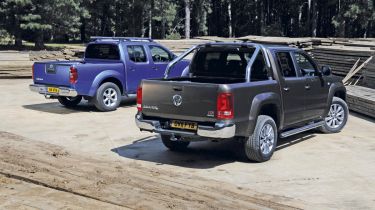VW Amarok vs Navara
Recent facelift keeps Navara fresh, while it’s better equipped than VW. Larger engine gives stronger pace, yet refinement and quality trail.

DOUBLE-cab pick-ups are the Swiss Army knives of the motoring world. So does the new Amarok multi-task more effectively than the Nissan Navara – our current favourite?
Volkswagen’s pick-up is certainly bigger in stature, especially in terms of width, where it trumps its rival by 106mm. The Amarok also looks more purposeful, thanks to its squared-off wheelarches and greater ground clearance.
The Nissan has been on sale for more than five years, but a facelift in 2010 means that it’s far from dated. Unlike the VW, though, the Navara is originally based on a seven-seater SUV – the Pathfinder – and the resemblance is clear to see. Chrome on the grille, door mirrors and rear bumper provide some glitz, while optional metallic paint minimises the visual impact of our car’s bluff proportions.
Climb into the cabin of the Amarok, and the firm’s familiar high-quality switchgear will ensure that VW owners feel at home straight away. Still, some of the harder plastics are a bit workmanlike, so there’s no escaping the pick-up’s commercial underpinnings.
A stint behind the wheel reveals that the Nissan is second best for interior quality – even the leather seat trim seems to be inferior. Yet there’s no shortage of kit in Tekna spec – electric front seats, a glass sunroof and multifunction steering wheel all come as standard.
Used - available now

2020 Peugeot
508
57,957 milesAutomaticDiesel1.5L
Cash £11,999
2021 Ford
Fiesta
9,955 milesAutomaticPetrol1.0L
Cash £16,699
2023 Ford
Puma
18,363 milesAutomaticPetrol1.0L
Cash £16,899
2020 Ford
Kuga
24,644 milesAutomaticDiesel2.0L
Cash £25,799However, the placement of some of the switchgear is rather haphazard, and the front seats don’t provide such a broad range of adjustment as those fitted to the VW. The Nissan does offer a fraction more legroom in the rear, but it doesn’t feel as spacious on account of its narrower bench.
Load space is where these two machines excel, and the Amarok wins this battle. Fill the load bays of both, and you will fit more into the newcomer thanks to an extra 110mm in length and 170mm between the rear wheelarches.
With their engines running, the two models have a gruffness unfamiliar to drivers of modern passenger cars. Still, while both suffer drivetrain vibration, the VW is more refined on the move. At motorway speeds, where its longer gearing comes into play, it’s a more relaxing choice. While the 2.0-litre bi-turbo powerplant in the VW is smoother, it can’t match the 2.5-litre six-cylinder in the Navara for sheer grunt. The BiTD is borrowed from the Caravelle, and does its best work low in the rev range – beyond 3,000rpm, you get more noise but little extra pace. The gearchange in the VW is hardly precise, but its action is far better than the vague and long throw you’re forced to endure when swapping ratios in the Nissan.
Dynamic thrills won’t be high on the agenda in either model, with their ageing ladderframe chassis and leaf-sprung rear suspension, and both require big steering inputs yet provide little feedback. But the Amarok is more fun and easier to live with.
The two pick-ups do get sophisticated AWD systems that offer front and four-wheel drive, plus low-range ratios. The VW also allows you to lock the centre differential, as well as that at the rear, so it’s capable off-road.
Private buyers will shell out the same £210 a year for a tax disc in both models, and company car users pay the same flat rate for benefit-in-kind tax, so there’s nothing to split them here. Instead, you need to look at the specifications to find key differences on cost.
The Nissan has a higher kit count and a lower list price than the VW, but servicing and insurance bills will be higher, judging by our findings. The Amarok also has the edge when it comes to economy; during its time in our hands, it returned 28.3mpg – that’s 0.5mpg more than the Navara.
In the final analysis, the Amarok failed to deliver a game-changing performance, but it still offers buyers in search of a family pick-up something new. Is it worth the premium?






